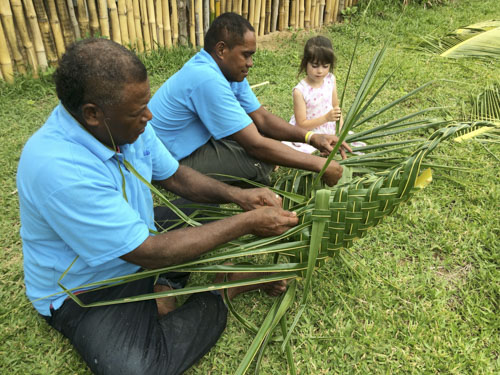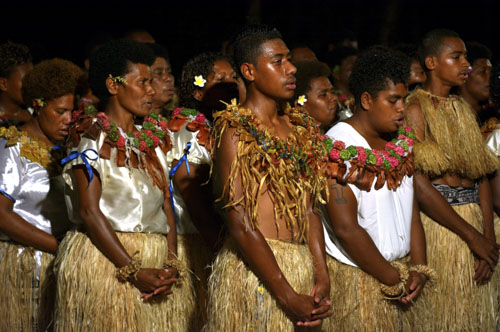A tropical island in Fiji
Written by Rochelle Guida
Language and Cultural Origin
While the exact origin of Fijian people is unknown, they have lived in Fiji since the second millennium BC. The word “Fijian” means “owners of the land.”
Fijian, also known as Boumaa Fijian, Eastern Fijian, Fiji, Standard Fijian, or Vakaviti, is part of the Oceanic branch of the Malayo-Polynesian language family. It is spoken by about 650,000 people in Fiji. About half of the country’s population speaks Fijian as their mother tongue, and the language is used in newspapers, on radio, and in schools. However, it only became an official language in 1997. Fijian is also spoken in New Zealand, Australia, and the USA.
The language follows a verb-subject-object order, with 23 or 24 letters. The written alphabet was created by Scotsman David Cargill, who used the Latin alphabetical system for the Fijian language. He worked with local Fijians to come up with an appropriate letter list.
Ni sa bula vinaka: Wishing You Happiness and Good Health!
While the natural landscape of white, sandy beaches and lush forests automatically generates a welcoming environment, the Fijian people themselves provide the warmest welcome. In fact, an important saying — Ni sa bula vinaka, which translates to wishing you happiness and good health — summarizes the “heart of Fiji culture.” Fijians often have strong, loving families and are equally loving to their community members. Essentially, no stranger is left feeling alone or unwelcomed by a Fijian. Or, as one travel blogger says, “Frankly, us Canadians are pretty well known for our politeness, yet these guys still put us Canucks to shame.”
Fijians are often considered artistic, since they use their land to produce beautiful objects. For example, they often make baskets or mats by hand. Whether it be tapa cloths, baskets, mats, or pottery, the craftsmanship is clearly decorative, but serves a greater, practical purpose — to provide “an everyday reminder of Fijian heritage.” Fijian food is also local and natural, reflecting elements of their land.

An important way in which Fijians express life lessons and traditions is through dance. The dances are often designed to share stories, preserving “the legends and tales passed down over the years,” including “elegant fan performances to rousing war dances.” In Fiji, you can also dance with just your hands, adding a unique element to storytelling that everyone, no matter their dancing ability, can take part in. The lesson below is based on this form of Fijian storytelling.

Dancing with Our Hands: Storytelling through Fijian Culture
Introduction
Objectives
- Students will develop their nonverbal and verbal communication skills through storytelling, primarily using their hands.
- Students will learn about Fijian culture through the Meke dance.
Materials
- Video of Fijian Meke dance performance
- Music from the Meke dance performance
- Large open space
Description
Procedure
- 5–10 minutes. Introduce the lesson by showing students a video of a Fijian Meke dance performance.
- 30 minutes. Explain to the students that in Fijian culture, the Meke dance is a way of telling stories through hand movements and gestures. Have students carefully watch and listen to a made-up hands dance, inspired by the Meke dance. Students should write down all the vocabulary and verbs that they hear in English. Notice the encouragement, the varied intonation, and the feelings of joy that the hand dance inspired. Students should share their findings with the whole group. The teacher should record the class’s findings for all students to consider for their own dance.
- 30 minutes. Divide the students into pairs and have them practice making hand gestures and movements to tell a story without speaking. Next, have students repeat the same story but with permission to use taught vocabulary and verb conventions of the class (using the target language). For example, if the current grammar focus of the language class is the past tense, have students create a made-up story using the past tense. Perhaps, if travel is the classroom’s current focus, the students can focus on travel words and actions.
- 30–60 minutes. After about 30 minutes of preparation and practice, have each pair perform their story for the class. Have the class discuss the different stories and what they learned about Fijian culture through the Meke dance.
- 15 minutes. Encourage the students to reflect on their own storytelling abilities, noting what they found challenging or easy about the activity. They can record this in their language journal or notebook. Use the target language for the reflection process.
Assessment and Extension
Assessment
- The creativity and effectiveness of the student’s hand gestures and movements in telling a story.
- The quality of the student’s participation during the activity and discussion.
- The student’s ability to make connections between the Meke dance and Fijian culture.
Extension
- Encourage students to create a longer and more elaborate story, incorporating more complex hand gestures and movements.




